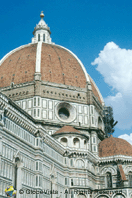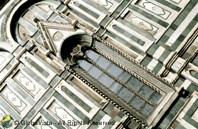Our Lady of the Flower
 The Santa Maria del Fiore is the Duomo (cathedral) of the Roman Catholic Archdiocese of Florence. Rising above Florences’s skyline, it is one of the most recognised landmarks of the city. The cathedral was built as a basilica, with a nave and two aisles, forming a Roman cross and it would take over 6 centuries to complete. It was given the name of Santa Maria del Fiore (Holy Mary of the Flower) in 1412 in honour of the lily, symbol of the city.
The Santa Maria del Fiore is the Duomo (cathedral) of the Roman Catholic Archdiocese of Florence. Rising above Florences’s skyline, it is one of the most recognised landmarks of the city. The cathedral was built as a basilica, with a nave and two aisles, forming a Roman cross and it would take over 6 centuries to complete. It was given the name of Santa Maria del Fiore (Holy Mary of the Flower) in 1412 in honour of the lily, symbol of the city.
Brief History
 The cathedral was built on the site of the old and crumbling cathedral, Santa Reparata. During this period Florence was the most politically and economically powerful city in Tuscany but its prosperous city cathedral was overshadowed by the magnificently built cathedrals of rival cities, Siena and Pisa.
The cathedral was built on the site of the old and crumbling cathedral, Santa Reparata. During this period Florence was the most politically and economically powerful city in Tuscany but its prosperous city cathedral was overshadowed by the magnificently built cathedrals of rival cities, Siena and Pisa.
A new church was in order and plans were underway to make it the grandest of all. In 1296, the head architect of the City Council Arnolfo di Cambio, drew up plans for the construction of the largest Roman Catholic church in the world. Arnolfo was already responsible for the Santa Croce and the Palazzo Vecchio.  Arnolfo wanted a predominately gothic style cathedral and envisaged the complex to feature three wide naves which would meet in the chancel (where the high altar stands) surrounded by the trefoil shaped tribune (representing the petals of a flower) on which the dome (cupola) would rest.
Arnolfo wanted a predominately gothic style cathedral and envisaged the complex to feature three wide naves which would meet in the chancel (where the high altar stands) surrounded by the trefoil shaped tribune (representing the petals of a flower) on which the dome (cupola) would rest.
The foundation stone was laid on September 9th, 1296 by cardinal Valeriana, who was the first papal messenger to be sent from the Holy See to Florence. Unfortunately 6 years later, in 1302, Arnolfo died, and work slowed on his grand design.
In 1331 the Arte della Lana (Guild of wool merchants) took over the project funding and they appointed Giotto in 1334 to oversee the continued construction.  Assisted by Andrea Pisano, the two architects stuck closely to Arnolfo’s original design. Three years later Giotto was dead and the task was passed to Pisano. Pisano died in 1348 during the time of the Black Plague, though there is no evidence that he had succumbed to the epidemic. His greatest accomplishment during his time was the building the campanile (belltower).
Assisted by Andrea Pisano, the two architects stuck closely to Arnolfo’s original design. Three years later Giotto was dead and the task was passed to Pisano. Pisano died in 1348 during the time of the Black Plague, though there is no evidence that he had succumbed to the epidemic. His greatest accomplishment during his time was the building the campanile (belltower).
Work continued in 1349 under the watchful eye of a series of architects including Francesco Talenti, Giovanni di Lapo Ghini, Alberto Arnoldi, Giovanni d’Ambrogio, Neri di Fioravante and Orcagna who all fiddled with the original design. Around 1375 orders were finally given to pull down the old church of Santa Reparata.
Today you can see some archaeological remains of the church underneath the cathedral.  In 1380 the nave ( central approach to the high altar) was completed and by 1418 only the dome was left to complete. The dome had been a constant embarrassment for the city, as no one quite knew how to build it.
In 1380 the nave ( central approach to the high altar) was completed and by 1418 only the dome was left to complete. The dome had been a constant embarrassment for the city, as no one quite knew how to build it.
In frustration, the city organised a competition to attract the great architectural minds of the country to find a solution. The answer lay in the design of the sculptor, Brunelleschi, who drew his inspiration from the great dome of the Pantheon. The cathedral was consecrated by Pope Eugene IV on March 25th, 1436, following the completion of Brunelleschi’s dome some 140 years after the first stone was laid. In the 16th century, the floor was laid in marble.
However, the cathedral’s facade remained unfinished and it would remain unfinished until another competition 428 years later.
The Windows
 The church features 44 stained glass windows, the largest undertaking of this kind in Italy during the 14th and 15th century. The windows in the aisles and in the transept depict saints from the Old and the New Testament, while the circular windows in the dome and above the entrance depict Christ and Mary.
The church features 44 stained glass windows, the largest undertaking of this kind in Italy during the 14th and 15th century. The windows in the aisles and in the transept depict saints from the Old and the New Testament, while the circular windows in the dome and above the entrance depict Christ and Mary.
The windows are the work of some of the greatest Florentine artists of the time including Donatello, Lorenzo Ghiberti, Paolo Uccello and Andrea del Castagno. Of the six lateral windows built, only four bring in light whilst the other two are purely ornamental.
The Doors
The Door of the Canonici (south side) and the Door of the Mandorla (north side) were the creation of Nanni di Banco, Donatello and Jacopo della Quercia.
The Dome
 Originally the cathedral had a wooden dome built by Arnolfo di Cambio over the area but when it came to designing a stone dome technical problems arose. The solution was to hold a competition for the design of a new dome (cupola). So in 1419, the “Arte del Lana” ran the contest with the two main competitors being Lorenzo Ghiberti and Filippo Brunelleschi.
Originally the cathedral had a wooden dome built by Arnolfo di Cambio over the area but when it came to designing a stone dome technical problems arose. The solution was to hold a competition for the design of a new dome (cupola). So in 1419, the “Arte del Lana” ran the contest with the two main competitors being Lorenzo Ghiberti and Filippo Brunelleschi.
In the end, the closely contended competition was won by Brunelleschi whose design was inspired by the cupola of the Pantheon in Rome. Brunelleschi’s design, a double-walled dome, was designed to rest on a drum rather than the roof itself, which meant there was no need for scaffolding. To create the dome Brunelleschi created several models and invented special hoisting machines to lift the large stones. Click here for more information about Brunelleschi’s Dome.
What a Facade
 The original facade was designed by Arnolfo di Cambio but was only completed in the lower portions of the cathedral. Grand Duke Francesco de’ Medici saw the facade as outdated and an eyesore, so he ordered Medici court architect, Bernardo Buontalenti, to dismantle it between 1587-1588.
The original facade was designed by Arnolfo di Cambio but was only completed in the lower portions of the cathedral. Grand Duke Francesco de’ Medici saw the facade as outdated and an eyesore, so he ordered Medici court architect, Bernardo Buontalenti, to dismantle it between 1587-1588.
Indecision and corruption meant designs by Giovanni Antonio Dosio, Giovanni de’ Medici with Alessandro Pieroni and Giambologna were all rejected over the ensuing years. The facade would lay bare for the next 270 years until a new competition was held for the design a new facade.
The winner was Emilio De Fabris (1808-1883) in 1871 with a neo-gothic design. Work commenced in 1876 and was completed in white, green, and red marble in 1887.
The facade features alternate vertical and horizontal bands of coloured marble from around Italy including Carrara (white), Prato (green) and Siena (red). The theme was followed through to the Baptistery and belltower. Between the rose window and the tympanum, there is a gallery with busts of great Florentine artists.
Interesting Facts About The Duomo
There is a gnomon (an ancient astronomical instrument) inside the cathedral and has been there since it was built. The gnomon was used to calculate the position of the sun or more importantly to calculate the summer solstice ( a time of harvest). When the sun is in the right position and the rays pass through the bronze plate inside the cathedral’s dome where a luminous circle appears on the marble floor below. This occurs for a few minutes during the end of May to the end of July.
The residents of Florence were expected to assist in the costs of building the elaborate cathedral and all last wills and testaments had a ” building of the Cathedral ” tax placed on them.
During the floods of 1966 the bronze doors of the Baptistery were broken open with the power of the water. The torrent of water engulfed Donatello’s wooden Magdalene and the doors of Paradise by Ghiberti and the doors by Andrea Pisano.
Giuliano de’ Medici (1453 – 1478), second son of Piero de’ Medici (the Gouty) and co-ruler of Florence, with his brother Lorenzo the Magnificent, was assassinated on Easter morning of April 26th, 1478 inside the cathedral by Francesco de’ Pazzi and Bernardo Baroncelli. Known as the “Pazzi conspiracy” they planned to kill both Lorenzo and Giuliano de’ Medici and replace the rulers with Girolamo Riario, a nephew of Francesco della Rovere, who was reigning as Pope Sixtus IV. Poor Giuliano was stabbed nineteen times.
On July 17th, 1600 Verrocchio’s copper ball crowning the dome of the cathedral was struck by lightning and fell to the ground. The ball containing holy relics was replaced two years later.
When Brunelleschi died in 1446 he was buried in Santa Maria del Fiore though his tomb, was not discovered until 1972.
Brunelleschi wanted the interior of the dome to glimmer with gold, but when he died in 1446 the walls of the dome were whitewashed only later to be painted with a representation of The Last Judgment.
